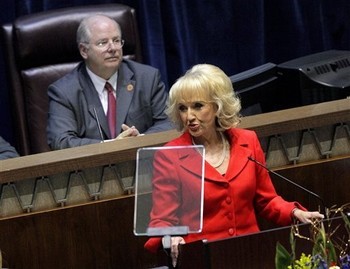Momentum is building to cut or eliminate Arizona’s capital gains tax.
In January, Gov. Jan Brewer (R) included in her proposed fiscal agenda for the year the broad goal of lightening the tax load on capital gains income. Although she remained agnostic on how to do it, several bills filed in the legislature were aimed at phasing out the tax over a period of years. Another would eliminate it in a single year.
Recognizing the importance of lowering taxes on capital as a way of spurring job growth, House Speaker Andy Tobin (R) decided to make elimination of the capital gains tax part of his “jobs bill” for the year. That package passed the House and awaits final action in the Senate.
Most states with income taxes tax capital gains income as “ordinary income” at the standard rates outlined in their tax code. However, eight states tax capital gains income at a lower effective rate, usually through the use of deductions from gross income.
Legislators in both the Arizona House and Senate heard testimony that highlighted the favorable economic impact of lowering taxes on capital gains income.
Increased Investment Incentive
Garrick Taylor, vice president of communications for the Arizona Chamber of Commerce and Industry told the House Ways and Means Committee in January, “Reducing the tax on capital gains increases the incentive for entrepreneurs and investors to risk their own capital in order to expand and create new businesses.”
Research from the Arizona-based Goldwater Institute, building on numerous academic studies on the subject, concluded the eight states that maintain favorable tax treatment for capital gains had, on average, approximately a 35 percent higher average net job creation rate between 2000 and 2007 than states that tax capital gains as ordinary income.
Another important element of capital gains cuts is they encourage increased investment in a healthy way. Many states often find themselves prone to enticing companies to invest in their state through subsidies and favorable tax treatment that isn’t available to other companies. This form of cherry-picking in the tax code—which some have termed corporate welfare or industrial policy—has been shown to be a poor economic development strategy over the long run even if it appears to increase job growth in the short term.
Capital gains tax cuts, by contrast, apply “to every business or individual that realizes a gain. Instead of picking certain industries or certain sectors that are going to qualify for favorable treatment,” notes Steve Voeller, the president of the Arizona Free Enterprise Club.
Big Cut, Big Gain
New Mexico is perhaps the best example of a state that attracted new investment by reducing the tax on capital gains. In 2003, Gov. Bill Richardson (D) proposed and signed into law what amounted to a 50 percent cut in the tax on capital gains relative to ordinary income. As a result, the average per-year venture capital investment in New Mexico almost quadrupled. It hoisted the state from 40th in the nation in terms of per-capita venture capital investment in 2003 to 13th in the nation by 2007 when the phase-in of the tax cut was fully implemented.
The question now is whether Arizona’s governor will agree to sign a phase-out of the tax on capital gains or simply a phased-in cut—probably in the range of a 50 percent to 60 percent –reduction—in the effective rate on capital gains by allowing at least a generous deduction for capital gains from gross income.
That means Arizona policymakers will soon choose between a zero rate on capital gains taxes and a rate of just under 2 percent. Doing either of these would place Arizona among an elite group of states that have enacted cuts in the tax rate on capital gains income over the past 25 years. And perhaps most importantly, Brewer’s signature would make Arizona the state with the lowest effective capital gains tax rate in the nation among those that tax income.
Stephen Slivinski ([email protected]) is senior economist at the Goldwater Institute in Phoenix, Arizona.




